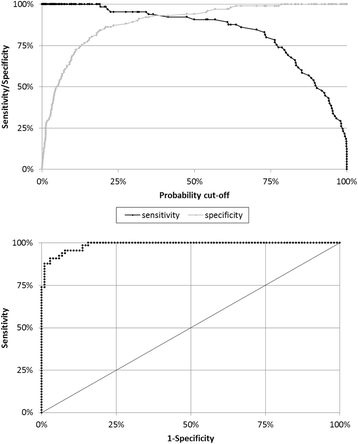Pancreatic ductal adenocarcinoma can be detected by analysis of volatile organic compounds (VOCs) in alveolar air
- PMID: 29728093
- PMCID: PMC5935919
- DOI: 10.1186/s12885-018-4452-0
Pancreatic ductal adenocarcinoma can be detected by analysis of volatile organic compounds (VOCs) in alveolar air
Abstract
Background: In the last decade many studies showed that the exhaled breath of subjects suffering from several pathological conditions has a peculiar volatile organic compound (VOC) profile. The objective of the present work was to analyse the VOCs in alveolar air to build a diagnostic tool able to identify the presence of pancreatic ductal adenocarcinoma in patients with histologically confirmed disease.
Methods: The concentration of 92 compounds was measured in the end-tidal breath of 65 cases and 102 controls. VOCs were measured with an ion-molecule reaction mass spectrometry. To distinguish between subjects with pancreatic adenocarcinomas and controls, an iterated Least Absolute Shrinkage and Selection Operator multivariate Logistic Regression model was elaborated.
Results: The final predictive model, based on 10 VOCs, significantly and independently associated with the outcome had a sensitivity and specificity of 100 and 84% respectively, and an area under the ROC curve of 0.99. For further validation, the model was run on 50 other subjects: 24 cases and 26 controls; 23 patients with histological diagnosis of pancreatic adenocarcinomas and 25 controls were correctly identified by the model.
Conclusions: Pancreatic cancer is able to alter the concentration of some molecules in the blood and hence of VOCs in the alveolar air in equilibrium. The detection and statistical rendering of alveolar VOC composition can be useful for the clinical diagnostic approach of pancreatic neoplasms with excellent sensitivity and specificity.
Keywords: Alveolar air; IMR-MS; LASSO logistic regression; Pancreatic adenocarcinoma; Volatile organic compounds.
Conflict of interest statement
Ethics approval and consent to participate
Ethics Committee of the Provinces of Verona and Rovigo approved this research: Prot. n. 15,802 date of registration: 30/3/2016, Prog. 879CESC.
Written informed consent was obtained from all subjects before study entry, which was conducted in compliance with the principles of the Declaration of Helsinki.
Competing interests
The authors declare that they have no competing interests.
Publisher’s Note
Springer Nature remains neutral with regard to jurisdictional claims in published maps and institutional affiliations.
Figures


Similar articles
-
Discriminant Profiles of Volatile Compounds in the Alveolar Air of Patients with Squamous Cell Lung Cancer, Lung Adenocarcinoma or Colon Cancer.Molecules. 2021 Jan 21;26(3):550. doi: 10.3390/molecules26030550. Molecules. 2021. PMID: 33494458 Free PMC article. Clinical Trial.
-
Analysis of Exhaled Breath Volatile Organic Compounds in Inflammatory Bowel Disease: A Pilot Study.J Crohns Colitis. 2015 Sep;9(9):731-7. doi: 10.1093/ecco-jcc/jjv102. Epub 2015 Jun 12. J Crohns Colitis. 2015. PMID: 26071410
-
Mass Spectrometric Analysis of Exhaled Breath for the Identification of Volatile Organic Compound Biomarkers in Esophageal and Gastric Adenocarcinoma.Ann Surg. 2015 Dec;262(6):981-90. doi: 10.1097/SLA.0000000000001101. Ann Surg. 2015. PMID: 25575255 Clinical Trial.
-
Evidence of endogenous volatile organic compounds as biomarkers of diseases in alveolar breath.Ann Pharm Fr. 2013 Jul;71(4):203-15. doi: 10.1016/j.pharma.2013.05.002. Epub 2013 Jun 17. Ann Pharm Fr. 2013. PMID: 23835018 Review.
-
Detection of volatile organic compounds (VOCs) from exhaled breath as noninvasive methods for cancer diagnosis.Anal Bioanal Chem. 2016 Apr;408(11):2759-80. doi: 10.1007/s00216-015-9200-6. Epub 2015 Dec 16. Anal Bioanal Chem. 2016. PMID: 26677028 Review.
Cited by
-
Volatile organic compounds as a potential screening tool for neoplasm of the digestive system: a meta-analysis.Sci Rep. 2021 Dec 9;11(1):23716. doi: 10.1038/s41598-021-02906-8. Sci Rep. 2021. PMID: 34887450 Free PMC article.
-
Volatile organic compounds for early detection of prostate cancer from urine.Heliyon. 2023 May 25;9(6):e16686. doi: 10.1016/j.heliyon.2023.e16686. eCollection 2023 Jun. Heliyon. 2023. PMID: 37303549 Free PMC article.
-
Pancreatic Cancer and Detection Methods.Biomedicines. 2023 Sep 18;11(9):2557. doi: 10.3390/biomedicines11092557. Biomedicines. 2023. PMID: 37760999 Free PMC article. Review.
-
A Systematic Review and Meta-Analysis: Volatile Organic Compound Analysis in the Detection of Hepatobiliary and Pancreatic Cancers.Cancers (Basel). 2023 Apr 14;15(8):2308. doi: 10.3390/cancers15082308. Cancers (Basel). 2023. PMID: 37190235 Free PMC article. Review.
-
Breath analysis for the detection of digestive tract malignancies: systematic review.BJS Open. 2021 Mar 5;5(2):zrab013. doi: 10.1093/bjsopen/zrab013. BJS Open. 2021. PMID: 33855362 Free PMC article.
References
-
- Stewart RD. The use of breath analysis in clinical toxicology, in Wayland I, Hayes J (ed): Essay in toxicology. NY Academic Press; 1974. P. 121–147.
-
- Gordon SM, Szidon JP, Krotoszynski BK, Gibbons RD, O'Neill HJ. Volatile organic compounds in exhaled air from patients with lung cancer. Clin Chem. 1985;31:1278–1282. - PubMed
Publication types
MeSH terms
Substances
LinkOut - more resources
Full Text Sources
Other Literature Sources
Medical

